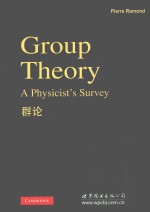

群论 英文PDF电子书下载
- 电子书积分:12 积分如何计算积分?
- 作 者:(美)雷蒙德著
- 出 版 社:上海:世界图书上海出版公司
- 出版年份:2014
- ISBN:9787510078712
- 页数:310 页
1 Preface:the pursuit of symmetries 1
2 Finite groups:an introduction 4
2.1 Group axioms 5
2.2 Finite groups of low order 6
2.3 Permutations 19
2.4 Basic concepts 22
2.4.1 Conjugation 22
2.4.2 Simple groups 25
2.4.3 Sylow's criteria 27
2.4.4 Semi-direct product 28
2.4.5 Young Tableaux 31
3 Finite groups:representations 33
3.1 Introduction 33
3.2 Schur's lemmas 35
3.3 The A4 character table 41
3.4 Kronecker products 44
3.5 Real and complex representations 46
3.6 Embeddings 48
3.7 Zn character table 52
3.8 Dn character table 53
3.9 Q2n character table 56
3.10 Some semi-direct products 58
3.11 Induced representations 61
3.12 Invariants 64
3.13 Coverings 67
4 Hilbert spaces 69
4.1 Finite Hilbert spaces 69
4.2 Fermi oscillators 70
4.3 Infinite Hilbert spaces 72
5 SU(2) 78
5.1 Introduction 78
5.2 Some representations 82
5.3 From Lie algebras to Lie groups 86
5.4 SU(2)→SU(1,1) 89
5.5 Selected SU(2)applications 93
5.5.1 The isotropic harmonic oscillator 93
5.5.2 The Bohr atom 95
5.5.3 Isotopic spin 99
6 SU(3) 102
6.1 SU(3)algebra 102
6.2 α-Basis 106
6.3 ω-Basis 107
6.4 α′-Basis 108
6.5 The triplet representation 110
6.6 The Chevalley basis 112
6.7 SU(3)in physics 114
6.7.1 The isotropic harmonic oscillator redux 114
6.7.2 The Elliott model 115
6.7.3 The Sakata model 117
6.7.4 The Eightfold Way 118
7 Classification of compact simple Lie algebras 123
7.1 Classification 124
7.2 Simple roots 129
7.3 Rank-two algebras 131
7.4 Dynkin diagrams 134
7.5 Orthonormal bases 140
8 Lie algebras:representation theory 143
8.1 Representation basics 143
8.2 A3 fundamentals 144
8.3 The Weyl group 149
8.4 Orthogonal Lie algebras 151
8.5 Spinor representations 153
8.5.1 SO(2n)spinors 154
8.5.2 SO(2n+1)spinors 156
8.5.3 Clifford algebra construction 159
8.6 Casimir invariants and Dynkin indices 164
8.7 Embeddings 168
8.8 Oscillator representations 178
8.9 Verma modules 180
8.9.1 Weyl dimension formula 187
8.9.2 Verma basis 188
9 Finite groups:the road to simplicity 190
9.1 Matrices over Galois fields 192
9.1.1 PSL2(7) 197
9.1.2 A doubly transitive group 198
9.2 Chevalley groups 201
9.3 A fleeting glimpse at the sporadic groups 205
10 Beyond Lie algebras 208
10.1 Serre presentation 208
10.2 Affine Kac-Moody algebras 210
10.3 Super algebras 216
11 The groups of the Standard Model 221
11.1 Space-time symmetries 222
11.1.1 The Lorentz and Poincaré groups 223
11.1.2 The conformal group 231
11.2 Beyond space-time symmetries 235
11.2.1 Color and the quark model 239
11.3 Invariant Lagrangians 240
11.4 Non-Abelian gauge theories 243
11.5 The Standard Model 244
11.6 Grand Unification 246
11.7 Possible family symmetries 249
11.7.1 Finite SU(2)and SO(3)subgroups 249
11.7.2 Finite SU(3)subgroups 252
12 Exceptional structures 254
12.1 Hurwitz algebras 254
12.2 Matrices over Hurwitz algebras 257
12.3 The Magic Square 259
Appendix 1 Properties of some finite groups 265
Appendix 2 Properties of selected Lie algebras 277
References 307
Index 308
- 《TED说话的力量 世界优秀演讲者的口才秘诀》(坦桑)阿卡什·P.卡里亚著 2019
- 《小手画出大世界 恐龙世界》登亚编绘 2008
- 《近代世界史文献丛编 19》王强主编 2017
- 《课堂上听不到的历史传奇 世界政治军事名人 初中版》顾跃忠等编著 2015
- 《365奇趣英语乐园 世界民间故事》爱思得图书国际企业 2018
- 《近代世界史文献丛编 36》王强主编 2017
- 《近代世界史文献丛编 11》王强主编 2017
- 《近代世界史文献丛编 18》王强主编 2017
- 《乐队伴奏长笛世界名曲集 4》芭芭拉·哈斯勒-哈瑟 2017
- 《世界名著阅读经典 欧也妮·葛朗台 高老头 全译本 12-16岁》(法)巴尔扎克著 2017
